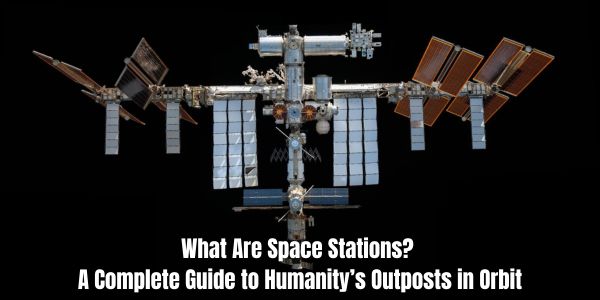Space stations are marvels of human ingenuity—orbiting habitats that push the boundaries of science, technology, and exploration. From the International Space Station (ISS) to historical pioneers like Skylab, these structures have transformed our understanding of space and life beyond Earth. But what exactly are space stations, how do they work, and why do they matter? This explainer dives into everything you need to know about space stations, their history, and their role in shaping the future of space exploration.
What Is a Space Station?
A space station is a crewed spacecraft designed to remain in orbit around Earth for extended periods, serving as a home, laboratory, and staging ground for space missions. Unlike satellites or short-term spacecraft, space stations are built for long-term human habitation, equipped with living quarters, research facilities, and systems to sustain life in the harsh vacuum of space.
- Key Features: Life support systems (oxygen, water recycling), solar panels for power, and docking ports for visiting spacecraft.
- Orbit: Most operate in Low Earth Orbit (LEO), typically 300–400 kilometers (186–248 miles) above Earth.
- Speed: They travel at roughly 28,000 kilometers per hour (17,500 mph), completing an orbit every 90 minutes.
The most famous example? The International Space Station, a collaborative effort that’s been continuously occupied since November 2000.
MUST READ
What Are Hypersonic Glide Vehicles, and How Do They Differ from Traditional Ballistic Missiles?
What Are Ballistic Missiles? An In-Depth Explainer
How Do Space Stations Work?
Space stations are engineering feats designed to function in microgravity, where traditional concepts like “up” and “down” don’t apply. Here’s how they operate:
- Launch and Assembly:
- Modules are launched piece-by-piece via rockets (e.g., SpaceX Falcon 9, Russian Soyuz) and assembled in orbit.
- Example: The ISS was built over decades, with its first module, Zarya, launched in 1998.
- Life Support:
- Oxygen is generated via electrolysis (splitting water molecules), and CO2 is scrubbed from the air.
- Water is recycled from urine and sweat—up to 90% efficiency on the ISS.
- Power:
- Solar panels capture sunlight, generating electricity (the ISS has eight solar arrays producing 75–90 kilowatts).
- Crew Operations:
- Astronauts conduct experiments, maintain the station, and exercise daily to combat muscle and bone loss in microgravity.
A Brief History of Space Stations
Space stations trace their roots to the Cold War space race:
- Salyut 1 (1971): The Soviet Union launched the world’s first space station. It hosted a crew for 23 days before being intentionally deorbited.
- Skylab (1973): NASA’s first station, built from an Apollo rocket stage, orbited until 1979, advancing solar and Earth science.
- Mir (1986–2001): Russia’s modular station set records for long-duration stays, paving the way for the ISS.
- International Space Station (1998–present): A partnership between NASA, Roscosmos, ESA, JAXA, and CSA, it’s the largest and longest-running station, orbiting Earth over 100,000 times by 2025.
Famous Space Stations and Their Missions
- International Space Station (ISS):
- Size: Roughly the length of a football field (109 meters/357 feet).
- Purpose: Microgravity research (biology, physics), technology testing, and international cooperation.
- Crew: Typically 6–7 astronauts, rotating every few months.
- Tiangong Space Station (2021–present):
- China’s modular station, fully operational by 2022, hosts 3–6 crew members for experiments and future lunar mission prep.
- Orbit: Around 340–450 km above Earth.
- Mir:
- Operated for 15 years, hosting 125 cosmonauts and astronauts from 12 countries.
Why Are Space Stations Important?
Space stations are more than orbiting labs—they’re critical to humanity’s future:
- Scientific Breakthroughs: Experiments in microgravity have led to advances in medicine (e.g., protein crystal growth for drug development) and materials science.
- Space Exploration: They test technologies for Mars missions, like life support and radiation shielding.
- Global Collaboration: The ISS unites nations in a shared goal, fostering diplomacy through science.
Challenges of Operating Space Stations
Running a space station isn’t easy:
- Cost: The ISS has cost over $150 billion to build and maintain.
- Space Debris: Over 27,000 tracked objects threaten collisions, requiring evasive maneuvers (29 by the ISS as of 2023).
- Health Risks: Microgravity causes bone loss (1–2% per month) and radiation exposure risks cancer.
- Logistics: Resupply missions (e.g., SpaceX Crew Dragon) are vital for food, water, and equipment.
The Future of Space Stations
The next decade promises exciting developments:
- Commercial Stations: Axiom Space plans to attach modules to the ISS by 2026, eventually detaching to form a private station.
- Lunar Gateway: A NASA-led station in lunar orbit, set for the 2030s, will support Artemis missions to the Moon.
- ISS Retirement: Slated for deorbit in 2031, it’ll crash into the Pacific Ocean’s “Point Nemo.”
How Space Stations Impact Everyday Life
Think space stations are irrelevant to you? Think again:
- Technology: Water purification and solar power tech trickle down to Earth applications.
- Weather: ISS instruments monitor climate patterns and natural disasters.
- Inspiration: They fuel STEM education and dreams of cosmic discovery.
Conclusion
Space stations like the ISS and Tiangong are humanity’s stepping stones to the stars. They blend cutting-edge science with international teamwork, overcoming immense challenges to expand our horizons. As commercial and lunar stations emerge, these orbiting outposts will continue to shape space exploration and life on Earth. Stay tuned—our cosmic journey is just beginning.

